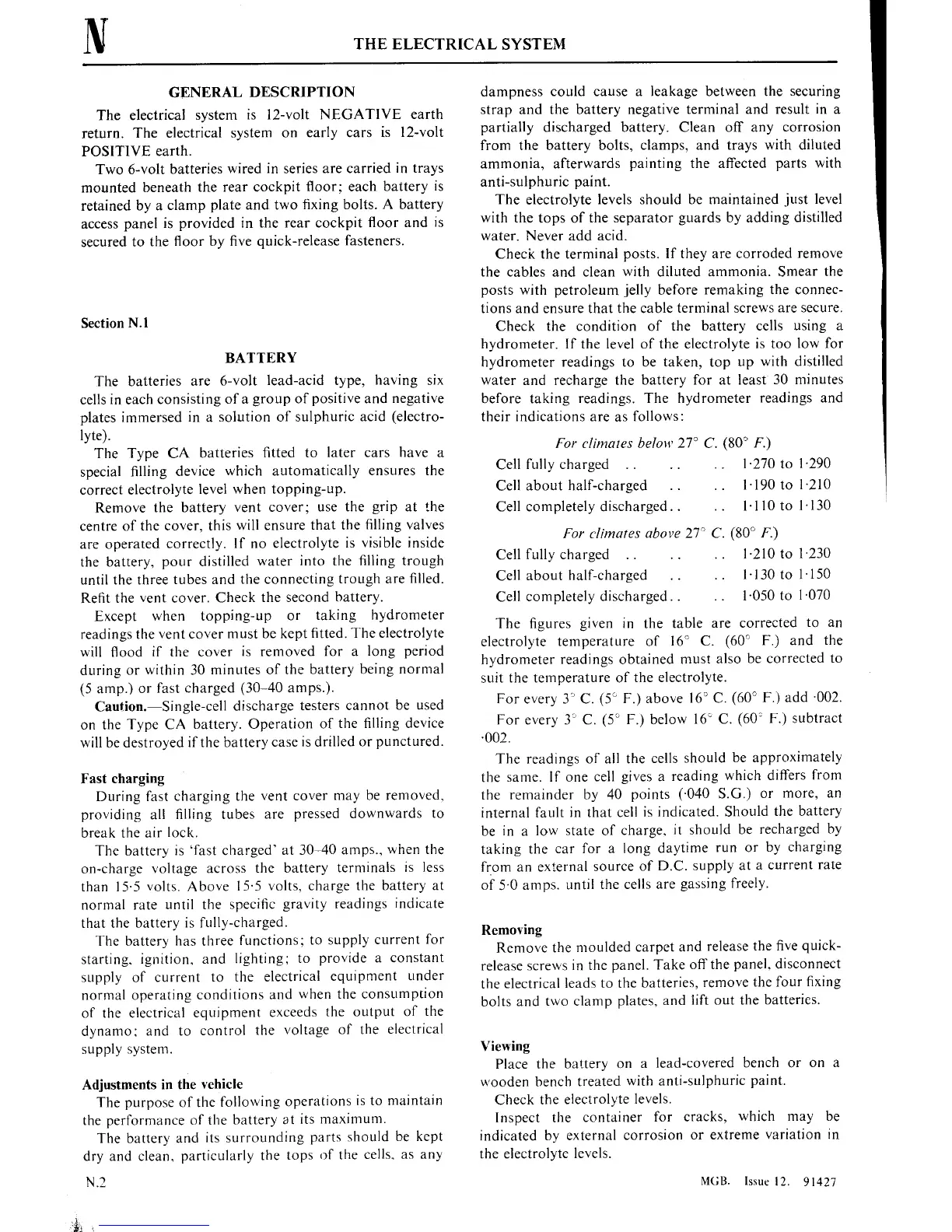N
THE ELECTRICAL SYSTEM
GENERAL
DESCRIPTION
The
electrical
system
is 12-volt NEGATIVE
earth
return.
The
electrical
system
on
early
cars
is lZ-volt
POSITIVE
earth.
Two
6-volt
batteries wired
in series
are
carried
in
trays
mounted
beneath the
rear
cockpit ■oor; each battery
is
retained by
a
clamp
plate and
two
■xing bolts. A battery
access
panel is
provided
in
the
rear
cockpit
■oor and is
secured
to
the
■oor by ■ve
quick—release
fasteners.
Section N
.l
BATTERY
The
batteries
are
6—volt lead-acid
type,
having six
cells
in each
consisting ofa
group
of
positive and negative
plates
immersed in
a
solution
of sulphuric acid (electro-
lyte).
The Type
CA
batteries ■tted
to
later
cars
have
a
special
■lling
device which
automatically
ensures
the
correct
electrolyte
level when
topping-up.
Remove
the battery
vent
cover; use
the
grip
at
the
centre
of
the
cover,
this will
ensure
that the
■lling valves
are
operated
correctly. If
no
electrolyte is visible inside
the battery,
pour
distilled
water
into the
■lling
trough
until
the three
tubes and
the
connecting
trough
are
■lled.
Re■t the
vent
cover.
Check
the second
battery.
Except
when
topping-up
or
taking hydrometer
readings the
vent
cover
must
be kept
■tted. The
electrolyte
will ■ood
if
the
cover
is removed
for
a
long period
during
or
within 30
minutes
of the battery
being
normal
(5
amp.)
or
fast
charged (30w40
amps.)
Caution.—Sing1e-cell discharge
testers cannot
be used
on
the Type
CA battery.
Operation of the
■lling device
will
be
destroyed
ifthe battery
case
is
drilled
or
punctured.
Fast
charging
During fast
charging
the
vent
cover may
be removed,
providing all
■lling tubes
are
pressed
downwards
to
break the
air lock.
The battery
is
‘fast charged’
at
30~40
amps,
when the
on-charge
voltage
across
the battery
terminals
is
less
than 15-5
volts. Above
15-5
volts, charge the
battery
at
normal
rate
until
the
speci■c
gravity
readings indicate
that the battery
is
fully-charged.
The battery
has three
functions;
to
supply
current
for
starting. ignition, and
lighting;
to
provide
a
constant
supply
of
current to
the
electrical
equipment
under
normal operating
conditions and
when the
consumption
of
the
electrical
equipment
exceeds
the
output
of the
dynamo: and
to
control the
voltage
of the
electrical
supply
system.
Adjustments in
the
vehicle
The
purpose
of the
following
operations
is
to
maintain
the
performance
of the battery
at
its
maximum.
The battery
and
its
surrounding
parts
should be kept
dry and clean,
particularly the
tops
of
the
cells.
as any
N2
dis.
a
dampness
could
cause
a
leakage between the
securing
strap
and the battery
negative terminal and result in
a
partially discharged battery. Clean off
any
corrosion
from the battery
bolts, clamps, and
trays
with diluted
ammonia, afterwards painting the affected
parts
with
anti-sulphuric
paint.
The
electrolyte levels should be
maintained just level
with
the
tops
of
the
separator
guards by
adding
distilled
water.
Never
add acid.
Check
the
terminal
posts.
1f
they
are
corroded
remove
the
cables and clean
with
diluted ammonia.
Smear
the
posts
with
petroleum jelly before
remaking
the
connec-
tions
and
ensure
that the
cable
terminal
screws are
secure.
Check the
condition of the battery
cells
using
a
hydrometer.
1f
the
level of the electrolyte
is
too
low
for
hydrometer
readings
to
be taken,
top
up
with
distilled
water
and recharge the
battery for
at
least
30
minutes
before taking readings. The hydrometer
readings and
their indications
are as
follows:
For
climates
below 27°
C.
(80° F.)
Cell fully charged
1-270
to
1-290
Cell about
half-charged
1-190
to
1210
Cell completely discharged.
.
1-110
to
1-130
For
climates
above 27°
C.
(800
F.)
Cell
fully
charged
1-210
to
1-230
Cell about
half-charged
1-130
to
1-150
Cell
completely discharged.
.
1-050
to
1-070
The
■gures
given in
the
table
are
corrected
to
an
electrolyte
temperature
of
160
C.
(600 F.)
and the
hydrometer
readings obtained
must
also be
corrected
to
suit
the
temperature
of
the
electrolyte.
For
every
3”
C.
(50
F.)
above
160 C.
(600 F.)
add -002.
For
every
3C
C.
(5“
F.)
below
16C
C.
(603
F.) subtract
-002.
The
readings of all the
cells
should be
approximately
the
same.
If
one
cell gives
a
reading
which
differs from
the
remainder by 40
points
(-040 5.6.)
or
more, an
internal fault
in
that
cell is
indicated.
Should
the battery
be
in
a
low
state
of
charge.
it
should be
recharged by
taking
the
car
for
a
long
daytime
run
or
by
charging
from
an
external
source
of
DC.
supply
at
a
current rate
of
50
amps.
until
the
cells
are
gassing
freely.
Removing
Remove
the
moulded
carpet
and release
the
■ve
quick-
release
SCI‘eWS
in the
panel, Take
011“
the
panel,
disconnect
the
electrical
leads
to
the
batteries,
remove
the
four
■xing
bolts
and
two
clamp
plates,
and
lift
out
the
batteries.
Viewing
Place
the battery
on a
lead-covered bench
or
on a
wooden
bench
treated
with
anti—sulphuric
paint.
Check
the
electrolyte
levels.
Inspect
the
container for
cracks,
which
may
be
indicated
by external
corrosion
or
extreme
variation in
the
electrolyte
levels.
MGB. lssue12.
91427

